Few can deny that comics and graphic storytelling have become an influential force in 21st-century western culture. Academic departments and programmes that concentrate on its study are growing. It fills the small screen and the big screen and is the focus of large, regular weekend gatherings around the continent. Its importance is emphasized by the amount of commerce that it continues to generate. Understandably, the epicentre of this comic ‘Big Bang’ is the United States and the genius of individuals like Siegel and Shuster and Lee and Kirby. Action Comics No. 1 occupies a preeminent place in this comic cosmology.
In comparison, our own Canadian comic universe is a tempest in a teapot with few people aware of its beginnings. That brief, almost accidental, half-dozen year comic book window that produced our first Canadian comics during World War II was, for the longest time, more like a forgotten ‘lost world’ than part of our Canadian socio-cultural fabric. The landscapes of Maple Leaf, Anglo-American, Bell Features, and Educational Projects roll-up fiction existed more like Kong’s Skull Island or Pellucidar than part of our remembered history for decades. Whenever garage or estate sales, or farmer’s barns spat up related artifacts, they were most often regarded as valueless curiosities or even nuisances within the clumps of American comics we could net.
Now that we’re beginning to ‘crack’ that mysterious world of Canada’s first comics, we’re finding out that what we know, like Canadian culture in general, is funnelled through Toronto. Bell Features and Anglo-American comics are the ones that show up most regularly and Bell Features books are the ones most commonly housed in the archive repositories around the country. Toronto area World War II creators were most accessible for invites to cons of the last century and early part of this century, again, that were held in Toronto. My own book, Heroes of the Home Front, had Bell Features creators as its focus. Availability and accessibility of resources and documents have handcuffed us into becoming Ontario- and Toronto-centric in our approach to these comics.
However, the proper beginning of Canadian comics – the locus of its ‘Big Bang’ – was in Vancouver. Canada’s west coast Maple Leaf Publications has always been the least explored territory of Canada’s World War II comic world. I hope that we will eventually get a solid repository of these scarce books somewhere in the country so that this can be rectified.
Canada’s comics started with the cover date ‘March 1941’. As any comic book collector will know, comics (and magazines) with this cover date were physically on the stands four to six weeks earlier. To get a sense of Canadian life at the time, take a look at the March 15, 1941 issue of Canada’s national magazine Maclean’s which would have been on the stands at the same time as Canada’s first comics and which you could have bought for half the cost or less of one of those comics.
There were actually a half-dozen comic books that appeared on Canadian stands with the cover date ‘March 1941.’ All but one were published by Toronto’s Anglo-American Publications. The five Anglos included the four mysterious, and apparently illegal (according to the War Exchange Conservation Act), direct reprints of American Fox issues (Big 3 Comics No. 2, Fantastic Comics No. 16, Mystery Men Comics No. 20, and Weird Comics No. 12).
The other Anglo was the 16 page,tabloid-sized collection of Ted McCall’s Robin Hood dailies from the Toronto Evening Telegram that was Robin Hood Comics Vol. 1 No. 1 that didn’t very much resemble a comic book at all.
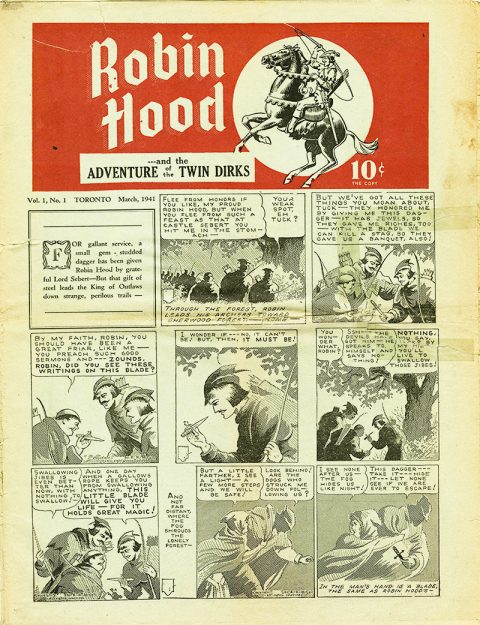
Front cover. 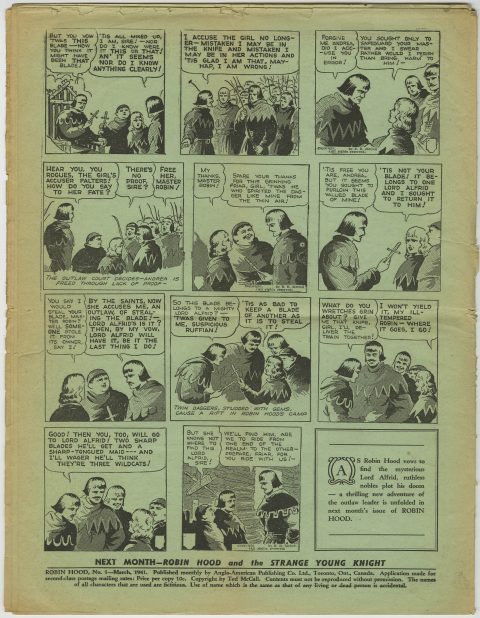
Back cover.
The remaining March 1941 Canadian comic was Maple Leaf Publications’ Better Comics Vol. 1 No. 1. It was the most significant of the lot.
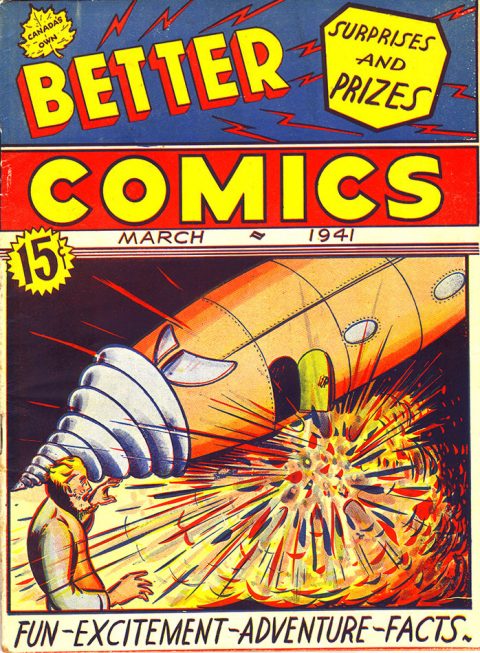
This is the one we have to regard as Canada’s first comic book. It was completely original content. It even had some full-colour pages and it introduced us to the first superhero to appear in a Canadian comic book: The Iron Man. This comic was almost entirely the work of one Vernon Hope Miller, born in Winnipeg on July 2, 1912, and therefore of the same vintage as Adrian Dingle and Edmond Good. His family moved to Vancouver when Vernon was in his teens. When he was 28 Miller founded The Maple Leaf Publishing Company with Vancouver book entrepreneur Harry Smith and their first offices were at 818 Richards St. By the third issue of Better Comics, the company had moved to 849 Homer St. and this became its permanent home.
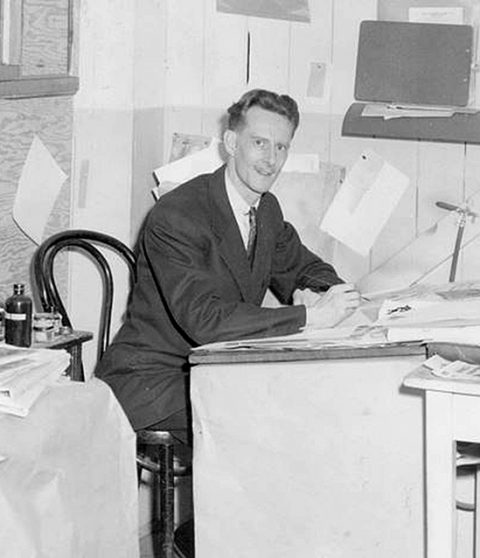
Vernon Miller was living next to Kitsilano Beach Park at 1218 Maple St. in Vancouver with his parents (his father, Gerald, was a real estate agent) and younger brother (Phil) and sister (Mavis) when the first issue of Better Comics came out. He endearingly dedicated the very first issue off the press to his parents at the bottom of its inside back cover and presented it to them. The family is still proudly in possession of this copy.
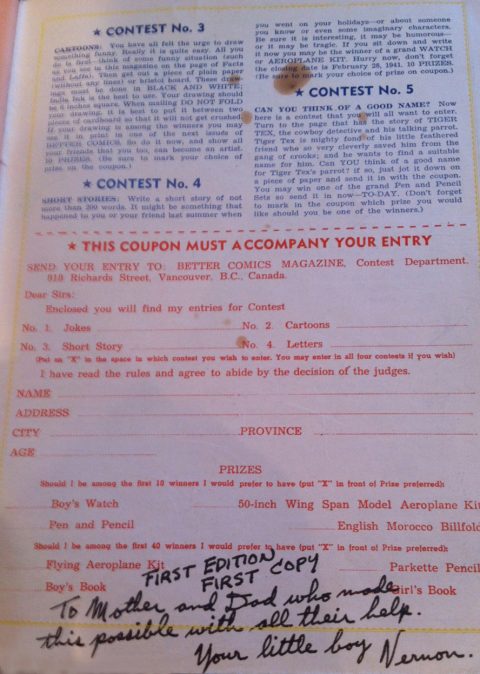
The cover of that first issue showed an explosion of primary colours emanating from just beneath the open door of a cylindrical screw-tipped vehicle with an older, bearded gentleman flinching from all the commotion. The cover was unusual in that it sported a 15¢ price tag rather than the regular dime price point.
Vernon Miller placed an introductory message to his audience on page seventeen just before the story about The Iron Man. It had a clear wholesome, positive, and nationalistic theme. It also attempted to engage the reader straight away into a partnership with the editors in the evolution of the comic itself by asking for input. This, I think, was a distinguishing characteristic of all the major Canadian World War II comic book publishing companies. They actively, through clubs, letter columns, and contests, sought suggestions and criticism from readers to an extent that never, to my knowledge, appeared in American comic books until much later.
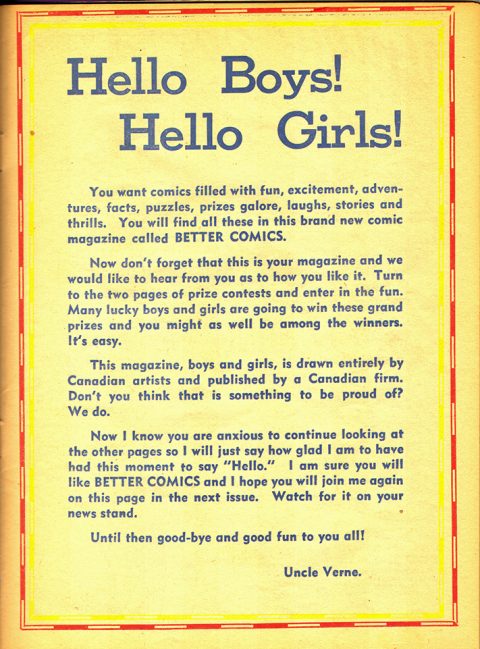
The first story up, written and drawn by Vernon Miller, is “The Earth Torpedo.” It’s about Professor Miles and his nephew Bobby who have just finished building a cylindrical vehicle with screw tips at either end. They call this ‘The Earth Torpedo.’ It can drill through the earth and solid rock with ease and the Professor plans to put it to work as a rescue and exploratory machine. By the second page, bad guys have co-opted the machine and force the professor to break into a bank vault. However, instead of bringing the bad guys back to their point of origin with their loot, the professor surfaces at the penitentiary and gets the culprits back to where they really belong.
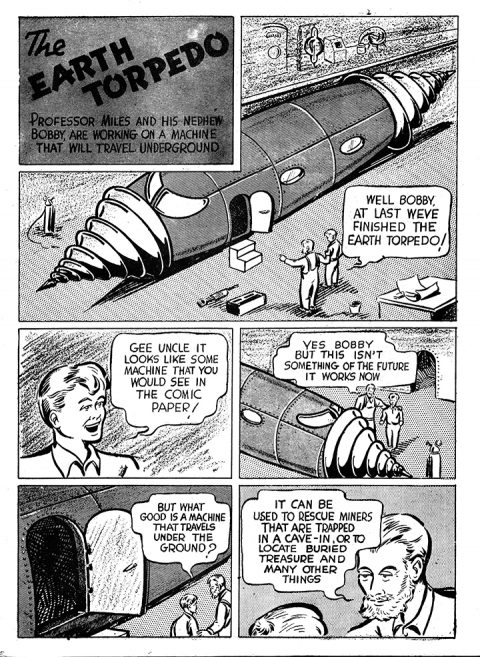
This same trope of an earth boring machine was used again a half-dozen years later by Tedd Steele for his villain, The Mole, when he battled Speed Savage in Triumph Comics Nos. 28 and 29.
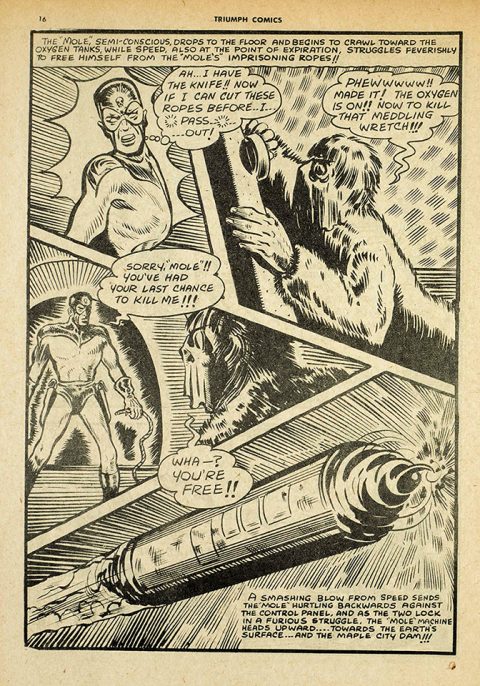
The next feature is a western with the unwieldy title, “Tiger Tex, The Cowboy Detective and his Talking Parrot.” Again, the strip is written and drawn by Vernon Miller. Tiger Tex is your typical all-round cowboy except for the fact that he rides the plains and solves crimes with a parrot on his shoulder.
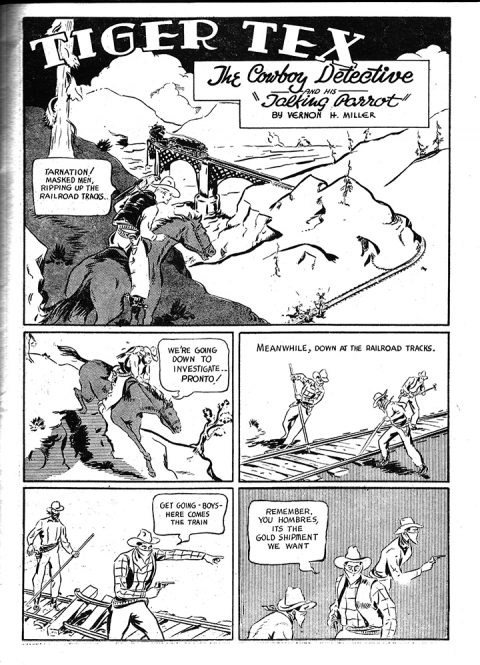
Tex captures a gang of train robbers with the help of the misdirection of his talking feathered pet. Though Tex refers to his avian sidekick as “Polly,” in this story, the last of five contests listed at the back of the book asks readers to suggest a name for the bird. The ‘Tiger Tex’ splash page for the third issue of the title announces that the name chosen for Tex’s partner in detection is “Echo.”
Miller had a gadget story with “The Earth Torpedo” and a western with “Tiger Tex,” but he knew he needed some sort of super-powered figure to make this into a proper comic book and he came up with his next feature about a character called “The Iron Man.” The phrase “Iron Man” in the first half of the last century conveyed the epitome of male physical fitness in opposition to the idea of the cowering ’98 lb. weakling.’ It was the aspirational endpoint of the male vector of the time and its residue still exists in the contemporary idea of the “Ironman Triathalon.”
Miller wrote and drew “The Iron Man” feature and he decided to distinguish it by making it a full-colour strip. “The Iron Man” has nothing to do with Tony Stark but is more akin to the Sub-Mariner and Aquaman. There are no credits, but the art clearly looks like rushed Vernon Miller and, for some reason, he doesn’t put his name on the strip until the fourth issue of the title.
The Iron Man is an undersea denizen of sunken civilization in the South Seas. It has survived in the form of a ‘Bubble City’ and The Iron Man survived because he “…possessed the faculties and powers far beyond his or our times–” Here are the first two pages of the story:
He appears to have some of Superman’s stock powers of super-strength, flying ability, and a certain invulnerability, but there is nothing Canadian about him or about any of these first three features other than the fact that they were created by a Canadian. Here are the fifth and seventh pages of the story:
With the fourth feature, “The Hidden Passage,” we find Miller sharing the credits as the illustrator with writer Frederick Percy Thursby. Thursby was born in Cork, Ireland on January 30, 1890, and came to Vancouver with his family in 1909 where he found work as a draughtsman. He seemed to exhibit an expertise in nautical history and chose to display it in this strip about 18th-century treasure hunting and pirates.
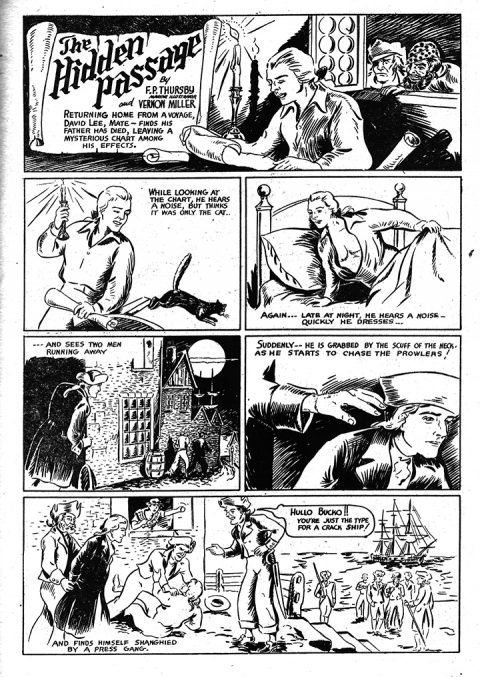
Thursby did a few amazing nautical illustrations that looked almost like etchings in the first issue of Lucky Comics and took over the strip completely for the fifth issue of Better Comics though, ironically, that was its last appearance. Thursby again tried his hand at his own strip with “The Modern Privateer” in Rocket Comics Vol. 3 No. 2. Thursby died in Vancouver in 1960.
The final feature, titled “The Roaring Rails” is, again, all Vernon Miller.
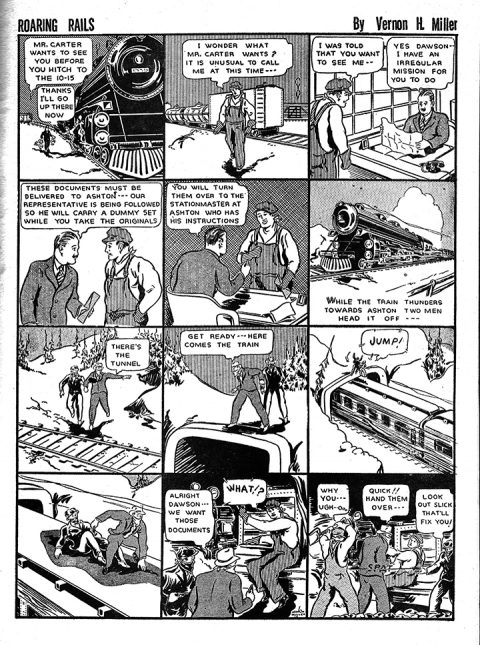
It has no splash panel and looks to me as if it could have been originally intended as a daily strip. It is railroad-themed and involves engineer Dawson Steele getting important papers to their destination. Dawson is waylaid by a pair of crooks who steal the papers and cause a train crash that is blamed on Dawson. At the end of the strip, Dawson sets out to right the wrong.
Better Comics Vol. 1 No. 1 is 90% Vernon Miller and 100% Canada’s first comic book. Besides Thursby’s contribution to “The Hidden Passage,” Ernie Walker, future artist on “Peter and Peggy and the Haunted Castle” and the “Lucky” saga in Lucky Comics and other strips created two full-colour pages called “Gnome Man’s Land” for the inside front cover and the back cover.
Still, there’s very little Canadian about the content of Better Comics Vol. 1 No. 1 other than the fact that it was created by Canadians and published in Canada. The stories aren’t set in Canada and the characters aren’t clearly distinguishable from any American characters. This, however, would soon change with creators like Bert Bushell, Spike Brown, Ley Fortune, and John Stables coming on board to build perhaps the very best of Canadian comic book publishing companies.
The first seven issues of Better Comics were published monthly and by the time that Freelance Comics Vol. 1 No. 1 came out in July-August, Better Comics had its fifth issue on the stands. The first issue of Triumph-Adventure Comics appeared on the stands alongside Better Comics Vol. 1 No. 6 and the first Bell Features comic, Wow Comics No. 1 sat on the stands alongside Better Comics Vol. 1 No. 7.
I know of the existence of only 5 copies of Better Comics Vol. 1 No. 1, all of them in remarkably good condition. This would put the scarcity of the book right on the cusp of a 9-10 Gerber scarcity rating. I doubt many more of these are going to show up for quite a while, if ever.
The importance of Vernon Miller and Better Comics Vol. 1 No. 1 to the story of Canadian comics cannot be understated. Given the political and economical window that the Second World War provided, Vernon Miller jumped in with both feet and was the first to show the Canadian audience what there was the opportunity to do. This Vancouver initiative led to the coalescence of comic book creativity in Toronto and eventually Montreal and is the mostly forgotten original source of our Canadian comic culture today.
INFO NOTE: Those of you going to TCAF this weekend. Ken Steacy will be signing his recent project done with Margaret Atwood about the Canadian comic scene of the ‘40s in Toronto titled War Bears. Check it out and chat with Ken about it. Ken’s wife, Joan, will also have her new work Aurora Borealice on show.

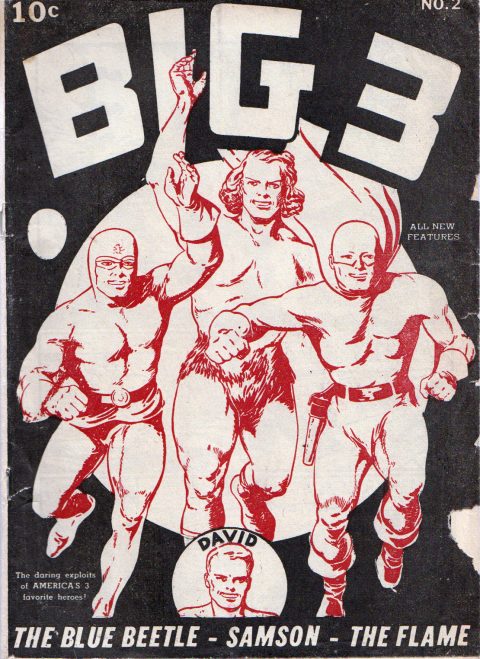
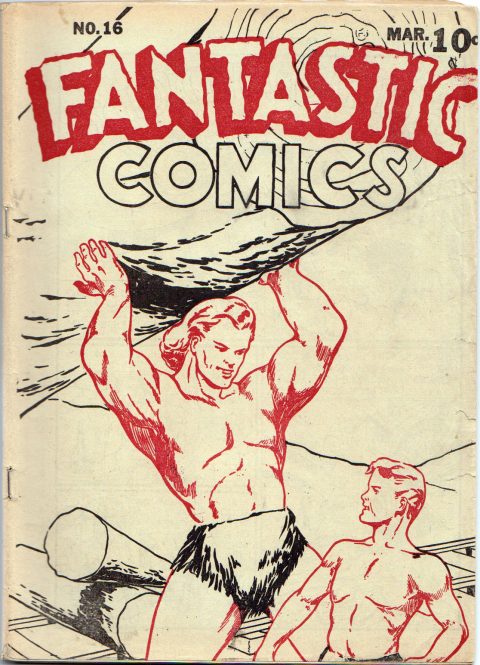
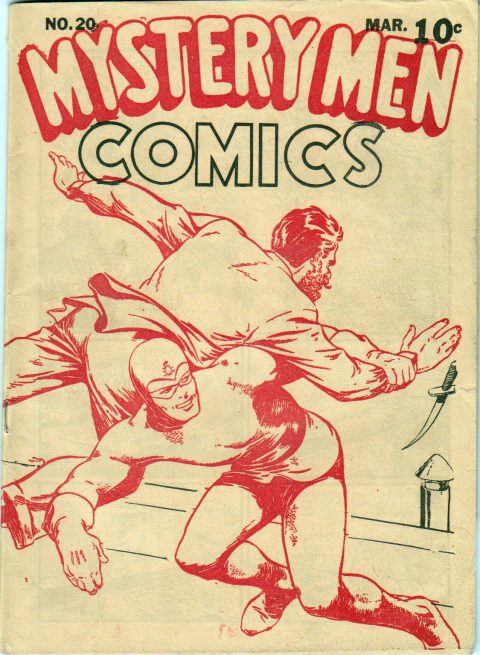
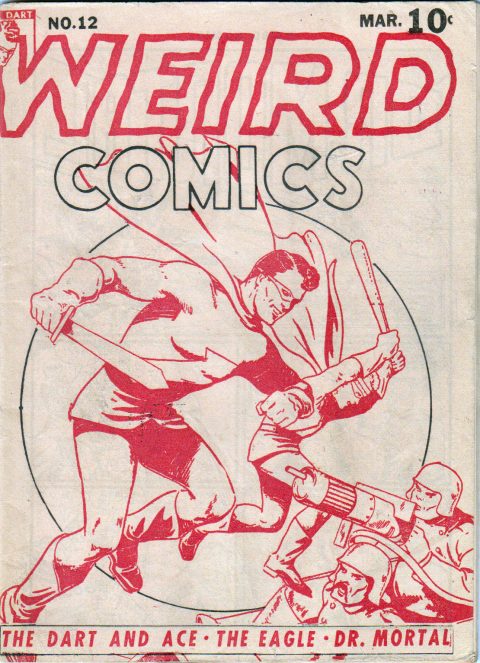
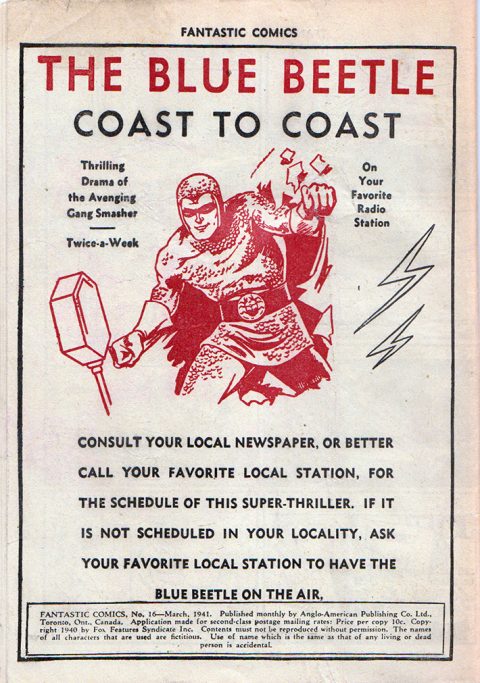
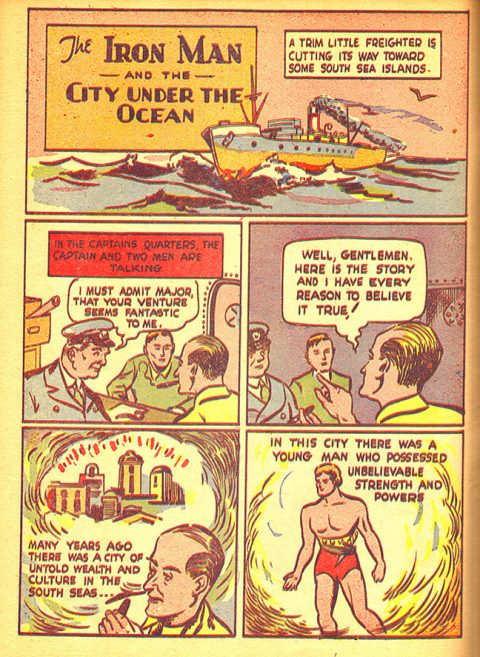
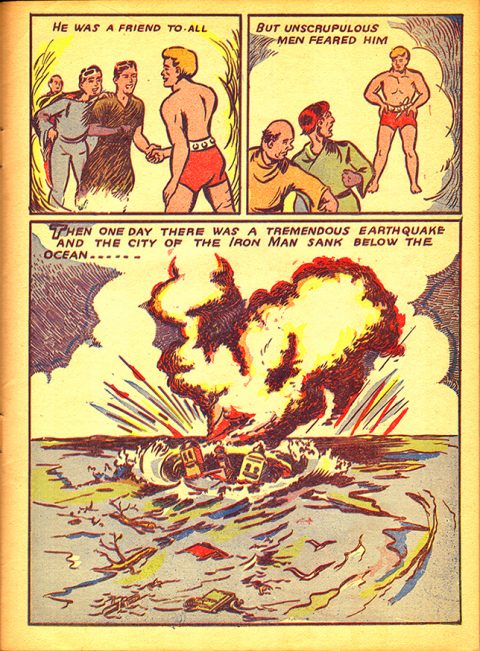
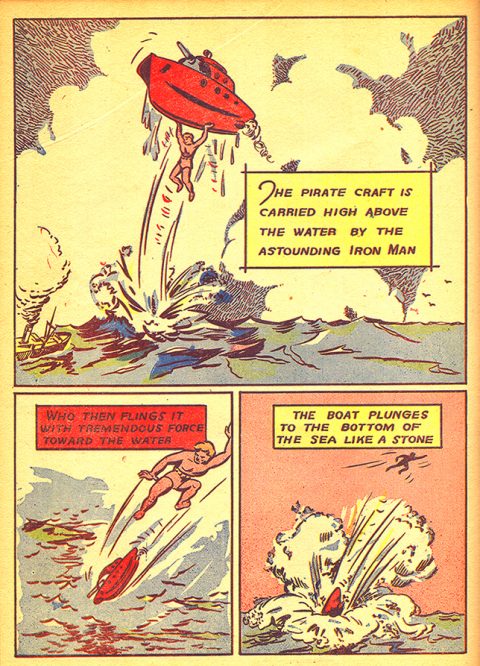
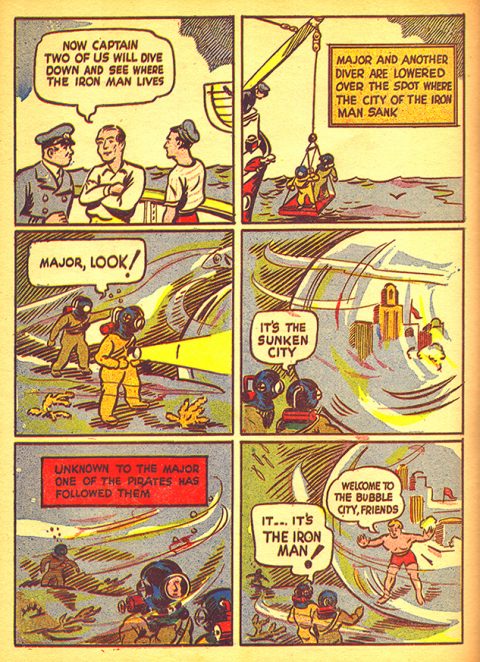
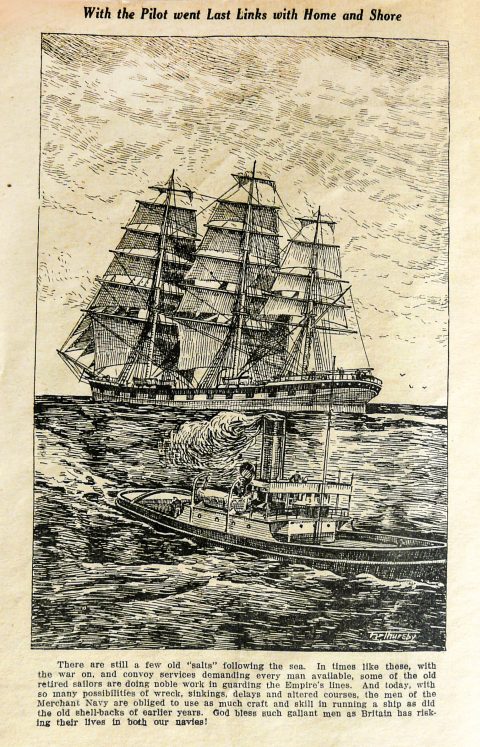
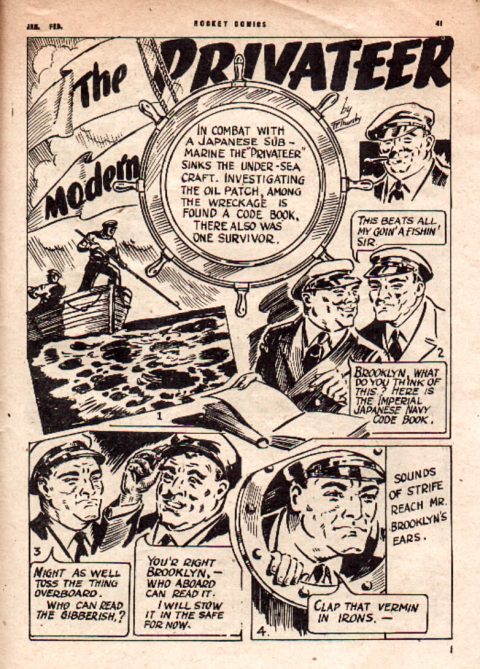
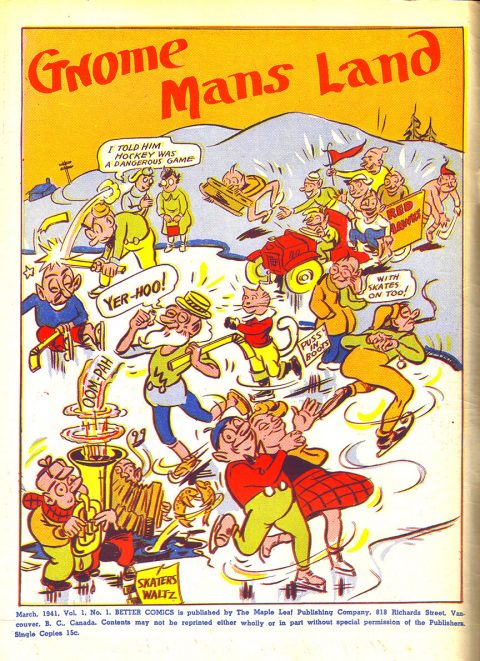
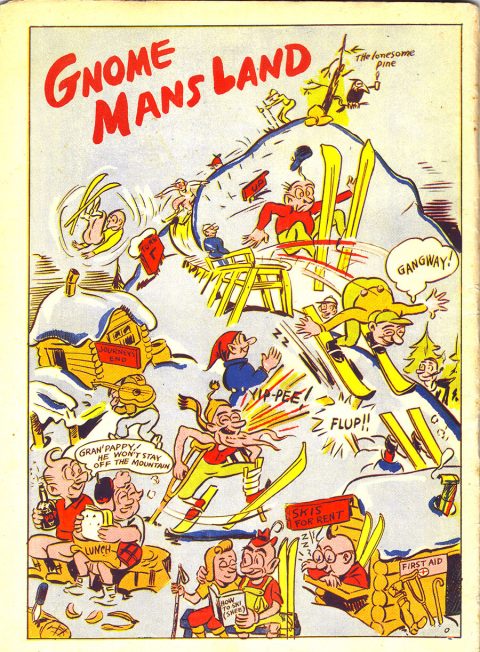



Ivan, you never cease to amaze me with the extent of your knowledge and your incredible research. Bravo!
I think you sell the Canadian content a bit short as it is well known that Canadian cowboys can be distinguished by their talking parrots. South of the border the saying is, “Parrots? We don’t need no steenking parrots!”
Ivan: A fabulous and informative post. Certainly there is info here that I had no idea about. Where did those first few AA issues come from?? I won’t make it to TCAF in Toronto this weekend but its sort of sad that neither the publisher, nor Ms. Atwood, nor Mr. Stacey have put together a complete edition of War Bears, maybe signed and numbered, that would be a bit of a shout out to those of us who are trying to preserve interest in Canadian WECA comics. At least there is no edition that I know of. In any case, when you talk about the split between Toronto and Vancouver and the relative accessibility of the Toronto published WECA comics, keep in mind that you live in the Golden Horseshoe of Ontario. If you lived in Western Canada you might find the Maple Leaf products more (relatively) common as I did when I lived in Vancouver. My experience is that the melting pot is Winnipeg with equal access to Toronto comics and Vancouver comics since it was the shipping nexus for trans-Canada shipments at the time. Maybe still is to some extent. Also, there was a population difference between Toronto and Vancouver as well as overall distribution issues leading to what I would suggest would be a significant difference in publishing volumes between the two centres and therefore more of the Toronto based product.
Thanks for your kind comment, Tony C. Chris, you may be right, but I would buy your idea more if it were a beaver or wolverine on Tiger Tex’s shoulder, but parrots aren’t native to the Great White North. Robin, a slim, hardcover trade collecting together the three issues of War Bears did come out last month, but it is not numbered and signed. Robin, you are correct in pointing out that what I wrote was from a sort of Toronto-centric perspective because it’s always been the part of Canada in which I’ve been based. Your suggestion about Winnipeg is a good one and I will have to make a trip out there because I don’t think it has been properly scoured and scraped for Canadian WWII comics.
Another excellent article on Canadian comics. I didn’t know about Tiger Tex. That has got to be one of the more weirder Golden -age characters.
I didn’t know that Robin Hood Comics v1_1 was only 16 pages since I’ve only seen slabbed copies and images of the front and back page which has no page number.
Thanks Ivan for saving me from bidding higher than US$3400 to find that out earlier.
I encourage everyone to scan and index more Canadian Whites and reprints like I do to increase our community knowledge and discussions of these books.
We all have knowledge to share with the rest of us who don’t have the so few and unique books that some of us have like Robin Hood #1.
You’re right, Ivan. Winnipeg sounds like a Great place for Canadian Whites collectors to Trek to in the near future.
Make it so #1, warp speed! since we all aren’t getting any younger!
Richards St. and Homer St. were part of my almost weekly walkathon from Kitsilano in the late ’60’s to ’80’s when I lived in Vancouver. All the way down to Chinatown occasionally and of course always to Ted Fraser’s Book Bin store just over on Granville St. If I had known of the Canadian Whites in that period I could have checked those addresses out and possibly could have found copies at the Book Bin. It had dozens and dozens of bins on casters at the bottom of the bookshelves full of magazines and pulps and who knows what. But I didn’t come across “The Great Canadian Comics” book until a used copy sometime in the late ’80’s and didn’t think to go looking for issues. It was neat to read about them but I was more into sf books at the time. 🙁
It’s not a polished, well drawn slick cover but it does have impact and gives off a “what’s going on?!” vibe which might move it off the newsstand into the hands of a kid. I’m 67 and I’d like to read this! Very home made, folk arty (which is sometimes more interesting than pro art). Love that Earth Torpedo, what a great tin toy it would have made. Good story and interesting to note that comics had multi genre characters rather than just supers at 15 cents an issue! What?! Tha’s highway robbery, I tell ya!! 🙂
Book collections would be nice but I’d kind of like to read full facsimile issues of these comics to feel “some” of that WW2 kid experience. Barring that, a Canadian Whites digital comics museum would be less tactile but an acceptable alternative.
Thanks, Ivan, great posts and am enjoying your book very much.
Peter, thanks for your appreciation of the column.
Jim, I don’t think that there are any slabbed copies of Robin Hood Comics Vol. 1 No. 1. It’s tabloid size makes it too large even for a magazine-sized slab. The only copy I’ve seen is that copy that was sold on CLINK and now is in Walter Durajlija’s possession. I think that it is the only known copy right now. Let’s think of organizing a jaunt out to the next Winnipeg con with a layover in Saskatoon to visit with Kirk Wallace.
Great to hear from you Tim. I’m 68 and I find all these old Canadian books magical. I just hope I can turn more people onto them. Also almost all the Bell Feature books have been digitized by the Library and Archives of Canada and you can find them and read them on its website.
Ivan, since you mentioned War Bears in brief, I want to take this opportunity to give it a huge shout out. Its a wonderful story. I think anyone interested in WECA books will get a big kick out of it. I don’t know if its kosher to put a link here, to my website listing of the book, so instead here’s my full description, partially based on my conversation with my old friend, artist Ken Steacy. He is now teaching but he liked the idea so much, he created his first new graphic novel in a decade. Although I didn’t care much for Margaret Atwood’s Angel Catbird series…Hope Nicholson pointed out I am NOT the target audience…with War Bears, Atwood (and Ken Steacy) hit a home run.
From the Booker Prize-winning author of The Handmaid’s Tale, comes this historical fiction graphic novel tracing the Golden Age of Canadian comic books. Oursonette, a fictional Nazi-fighting superheroine, is created at the peak of World War II by comic book creator Al Zurakowski who dreams of making it big in the early world of comics publishing. The story very accurately follows the early days of creating original comics in Toronto after the WECA ruling shut down importation of American comics. And it also portrays a brutal war that greatly strains the artist Al Z. personally and professionally.
Several short Oursonnete stories are woven into this larger tale–like the character that inspired her, Nelvana of the Northern Lights, Oursonnete fights wartime oppression. And in a fun variation from Nelvana, she can turn into a bear and is aided by two other bears, Ursa Major and Ursa Minor, in her battles against Nazi submarines, tanks, air attacks and more.
And finally, it very accurately describes how the rise of post-war American comics, once again allowed into Canadian markets, put an end to this fascinating period of Canadian creativity.
Inspired by a short prose story which Atwood wrote for the Sesquicentennial issue of the Globe and Mail–which is included here–veteran artist (and now teacher) Ken Steacy has come out of semi-retirement from comics to adapt, expand, and draw this unique story. He added a prequel, greatly expanded the story, and added a sequel that brings it nearly up to the present day, as the artist receives the real-life Shuster award for his long-forgotten work. The story closely parallels reality for one or more REAL artists from that time who HAVE been recognized, interviewed and feted in the past several years (see Heroes of the Home Front, for examples).
Internationally and New York Times best-selling novelist Margaret Atwood and acclaimed artist Ken Steacy collaborate for one of the most highly anticipated comic book and literary events!
Includes Forewords by Atwood and Ken Steacy, plus Afterwords by both creators. There are also insightful Introductions by artist and historian Trina Robbins and by historian Ivan Kocmarek, plus variant covers from the comic book series.
Atwood was born in 1946, too late to read the original comics but not too late to begin learning their history, beginning with the The Great Canadian Comic Books (1971). Who would have thought it, she was actually an aspiring artist herself before she turned to fiction. Her book A Handmade’s Tale became a bestseller and was adapted into an award-winning television mini-series.
War Bears on order, looking for another copy of the TGCC and subsequent books by John Bell, so I’m hooked in my old age!
I don’t have any WECA to scan and offer up but I do like to wear T-shirts so yes, I want to wear Canadian Comic hero shirts but there aren’t any. I’ve made some home-made iron-on transfers of some of my art and a few geeky things so I’m thinking of doing it myself for myself (seeking permissions). Not sure who or which comic to do first, maybe Heroes OTHH???? 🙂
Have looked at the LAC but not yet figured out their search engine hoops. One day.
Back to Better Comics – Miller would’ve been working on this 6 months or a year before so the focus would have been to put out a Canuck comic before the ban, maybe? Like you say, it’s not especially “Canadian” or promoting a Canadian identity so I wonder when that aspect kicked in. A cowboy with a talking parrot is no more odd ball than Nelvana’s brother turning into a great dane rather than a polar bear, or beaver, or moose which would be more Canadian but the oddity is kind of Canadian. Who was the first Canadian Canadian hero or character? (maybe you’ve covered this in another article, I’m reading from current backwards)
Hello Bud! Bud Plant was the supplier of many of my art books for many years even when I was moving around the west side of the country. He knows his stuff.
Thanks, Tim! There’s several archives now, though Nelvana is only available now as a print-on-demand edition from Amazon. Or in the after-market, try searching Bookfinder.com . Publisher Hope Nicholson says she has no margin to sell copies wholesale to me or I would offer it.
The collection of the original WECA Mr. Monster is long, long overdue. I need to check in with Michael Gilbert on that one, but he’s only contributing, he isn’t producing it. But we’ll have a signed bookplate he’s doing to go with it, he’s a great guy.
I like the Brok Windsor archive the best of all of them, after Nelvana. We still have it in stock. If you go on my website and search “canadian whites” you can see most of the archives and facsimile editions currently available. I wouldn’t be pushing my own website, but I don’t know where else all of them are collected. Most are not available on amazon and certainly not indexed there.
Maybe Ivan, or someone, could do a column with reviews of each one to date and where to find them, other than from me.
I hope to see more coming out, they are great fun to read.
I collect whites when I can, but only the lower cost ones. I think I have most of the more common, full color late Anglo-American issues now,, like the last issues of Grand Slam Three Aces and Freelance Robin Hood.
As I upgraded copies, I have listed my dupes on mycomicshop.com, where they currently are languishing, even though they are priced in line with Ivan’s WECA price guide. No one is finding them there, or the number of people looking for them are very few, or the serious collectors already have them. These issues are inexpensive, but still bargains compared to typical whites. And available in far better condition, in general. I think they are fun comics and good reads. If you look hard and are patient, you can still occasionally score these particular issues at bargain prices.
Thanks Bud! You’re still booking after all these years.
It was a year later but a news link led me to the Nelvana book so I was able to purchase one from a local shop who had a small counter display. I did manage to Kickstarter Brok & Johnny Canuck so those are proudly on my “Canadian Shelf”. Wasn’t able to fund Mr. Monster which is late but listed on Amazon for June (?). I was so looking forward to adding more Canuck comic books to my shelf but both publishers seem to have gone dark on Canadian war era comics. I did just buy Hope’s Polka Dot Pirate and WOW Comics #1 reprints. Might be fun to have a couple of actual whites to look at. I’ll look into it and thanks.
So what’s with the back cover on this Better Comics #1 Ivan? You don’t mention anything here on this post.
Is it really an ad for Wow Comics #1 as shown on the COC site, I would have figured that they (Maple Leaf) had a closer tie to Double A Comics as Imperial News was bought from the owners of Sinnott News.
Bud, it’s wonderful to have a sort of WECA comics “champion” down in the States. Thanks for supporting this forgotten, neglected, or even disparaged segment of Canadian comics history. I saw Ken at TCAF over the weekend and he was kind enough to sign my copy of War Bears, which I think will do a lot to generate more interest in WECA comics. Ken says that he is meeting with Margaret Atwood in a few weeks to discuss possible extensions of this project. Ken did that great cover of Speed Savage for my WECA Comic Price Guide. Rachel Richey put the Fred Kelly Mr. Monster material in Chapterhouse’s hands more than a year ago and they have done nothing with it so I don’t know how this is going to be resolved… let’s hope it turns out for the best.
Tim, that’s an interesting point you raise about how early Miller must have begun work on Better No. 1 to have it on the stands probably in February of 1941. The War Exchange Conservation Act did not pass until Dec. 6 but it must have been brewing in Parliament for a few months but I bet you it was pretty close to that date that Miller and his backer, Harry Smith, took the leap into comics. The first seven issues of Better comics were put out monthly and I can imagine the scramble that took place to get each issue out.
Jim B., I don’t know what happened on the Canada’s Own Comics site with the Better posting, but it was screwed up but I’ve fixed it now. Thanks for pointing that out. I do mention post the back cover for Better No. 1 in this post. It’s one of the two Gnome Man’s land pages by Ernie Walker.
So no variant copy then, just a misstep. Okay, that’s what I was wondering, I did note that you’d mentioned the Gnome page on the back thanks.
This may have been posted previously in one of Ivan’s articles but I just found it on the CBC Archive. A short portion of the CBC Telescope episode about the Loubert & Hirsh Great Canadian Comics documentary with footage of some of the artists and Cy Bell. Neat. (Would have put it in Ivan’s Heroes otHF article but comments are closed).
https://www.cbc.ca/archives/entry/superheroes-to-call-our-own
You can take the above message down if you want, the video clip is in one of Ivan’s columns further back. I shoulda known it would be – he’s encyclopedic!